Murray J.D. Mathematical Biology: I. An Introduction
Подождите немного. Документ загружается.

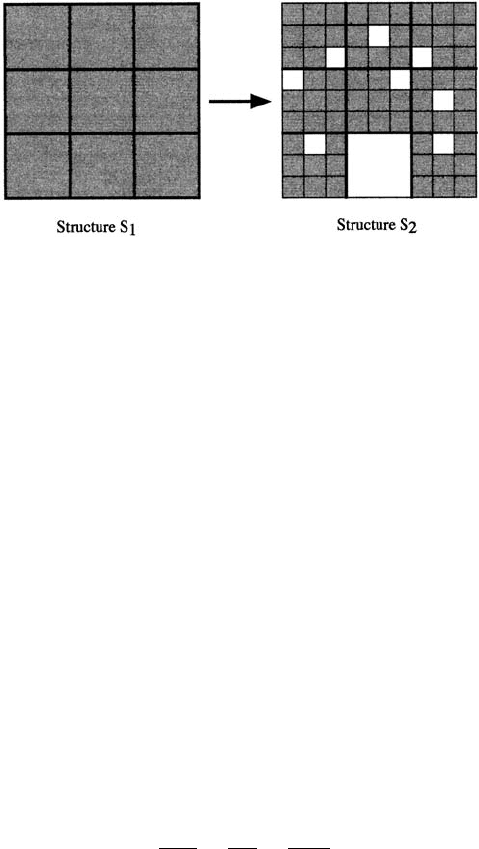
496 14. Use and Abuse of Fractals
Figure 14.8. Example of a nonself-similar fractal; see the text for a description of the generator.
the box size and plot ln N(r) against ln(1/r) for a range of r which gives a straight line
from which we can determine the gradient and hence D.
One problem with the box dimension is that it is not always easy to find the mini-
mal cover; the situations reproduced in Figures 14.7(a) and 14.7(b) highlight this. The
method in Figure 14.7(a) is actually better than that in Figure 14.7(b). There are other
more complex and more accurate methods for calculating the fractal dimension, one of
the best of which is the Hausdorff dimension which uses sets of shapes with different
sizes. Although mathematically it gives a more accurate value for the dimension it is
very much harder to calculate. A simple illustrative example of a nonself-similar fractal
is shown in Figure 14.8. The generating rule consists of starting with a square divided
into nine equal small squares. Then choose one at random and remove it from the figure
to get the set S
1
. The remaining eight squares are then divided into nine equal smaller
squares and again one of the smaller squares in each box is selected at random and
discarded to obtain S
2
. The procedure is then repeated. This is a fractal structure with
qualitatively similar structures at each scale reduction and there is a kind of power scale
law in operation in that the individual surviving boxes certainly obey one. How do we
calculate the box dimension of this fractal structure? If we take the length of the side
of the original square to be unity then S
1
consists of N = 8 equal squares of side 1/3;
that is, the scale r = 1/3. The set S
2
consists of N = 8
2
squares with scale r = (1/3)
2
.
At the nth generation we have a structure S
n
with N = 8
n
squares with side of length
r = (1/3)
n
. From (14.9) we thus have the box dimension given by
D = lim
n→∞
ln 8
n
ln 3
n
=
ln 8
ln 3
=
3ln2
ln 3
= 1.893.
It is left as an exercise to calculate the box dimension of the nonself-similar fractal
obtained if a similar procedure to that used in Figure 14.8 is used with the Sierpinski
triangle in Figure 14.4.
14.4 Fractals or Space-Filling?
Let us now consider a biological situation involving cells such as that shown in Fig-
ure 14.1, or the volume occupied by the alveolar sacs in the lung organism or the typical
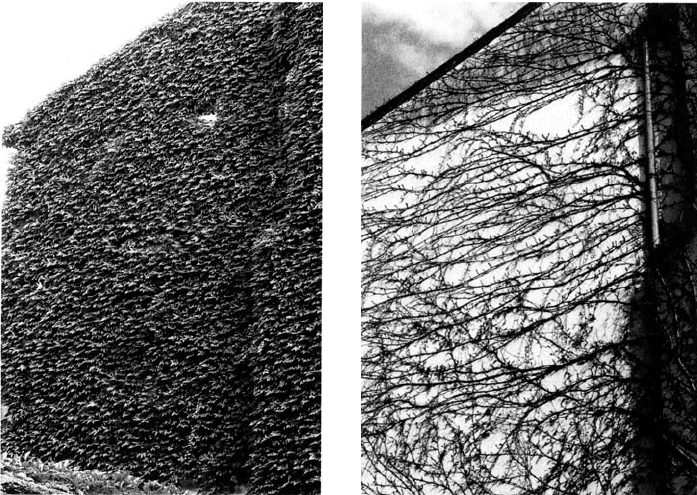
14.4 Fractals or Space-Filling? 497
(a) Summer (b) Winter
Figure 14.9. Ivy-covered wall in winter and summer. Is the branch structure in (a) fractal or is it space-filling
to optimise the leaf coverage (b) in the summer?
ivy covering of a wall as in Figure 14.9. Ideally, in the case of the lung, a major purpose
is to maximise the exchange of oxygen in the blood in the minimum amount of space.
In the case of the ivy the branches grow, it seems, so that they cover the available wall
space in the most efficient space-filling way for the leaves to maximise the absorption of
sunlight and relevant gases to maximise the growth in the growth season. Such branch-
ing structures are widespread in Nature; see, for example, the many fractal-like forms
in Nature, reproduced in almost all books on fractals. In the case of the neuronal cells
in Figure 14.1 are they space-filling or are they fractal?
In the latter part of the 19th century and the beginning of the 20th there was con-
siderable interest in space-filling curves. What we mean by that is for any patch in a
given area there is a curve which touches each point of that patch. We come back to
the biological relevance shortly. To see how to construct such a curve we consider the
classical space-filling curve first described by Hilbert in 1891. Figure 14.10 shows the
initial construction stages. Let us suppose the size of the line segments of the three-sided
figure in S
0
to be length 1. Then in the intermediate stage we have four such three-sided
figures with segment lengths of 1/2. We then join the four copies of S
0
with three lines
to get S
1
. The procedure is repeated to get S
2
using similar rotations and again joining
up the various quadrant curves with three other lines. So, S
2
has 16 copies of S
0
made
up of line segments of length 1/4. At stage S
n
we have 4n copies of S
0
made up of line
segments of length 1/2
n
.
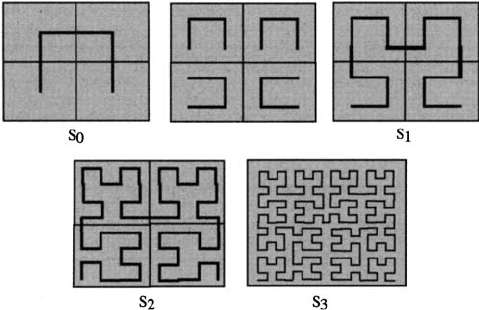
498 14. Use and Abuse of Fractals
Figure 14.10. The stepwise generation of the space-filling Hilbert curve. We start with the space and curve
S
0
, for the intermediate step in the second square and then join the four sets of lines to get S
1
,thenS
2
, S
3
and
so on. In the limit the curve passes through each point in the square.
The theory of space-filling curves gets quite technical mathematically but from a
biological viewpoint we do not need it. Suppose we have an organism which wants to
maximise its coverage of a given area or volume. One way to do this would be to have
a branching structure which obeyed local developmental branching rules to try and fill
all the available space. The evolution of the curve in Figure 14.10 is one possible rule.
In fact is the regularity of such a branching pattern any better than a random oppor-
tunistic branching which has a normal topological dimension and is not fractal, not self-
similar nor has any other of the elegant geometric properties associated with fractals?
The branching pattern, fractal or otherwise, stops when the interbranch distance is at a
specific scale associated with the specific organism. This would result in a fairly even
mesh within which there is no further structure. In fact it would be counterproductive
to try to create a finer structure than was necessary. By a careful analysis of retinal neu-
rons and vessels Panico and Sterling (1995) showed that neuronal and vascular patterns
showed no more self-similarity than the non-fractal controls they used. They concluded
that these biological patterns were not fractal but rather space-filling.
Although experiments might give rise to something that appears to be fractal, or
have a noninteger dimension, boundaries generally play a role in such measurements
and affect the subsequent log–log graphs. Whether or not something is fractal from
experimental measurements it must be clearly demonstrated that such boundary effects
can be ignored.
Caveat
It has frequently been suggested that if some pattern is fractal then we can infer some-
thing about the mechanism which generates it. The case most frequently cited is when
the pattern generated looks qualitatively similar to that in Figure 14.11 which is a typ-
ical pattern generated by diffusion limited aggregation. Diffusion limited aggregation
(DLA) is a diffusion process whereby particles exhibit a random walk behaviour and
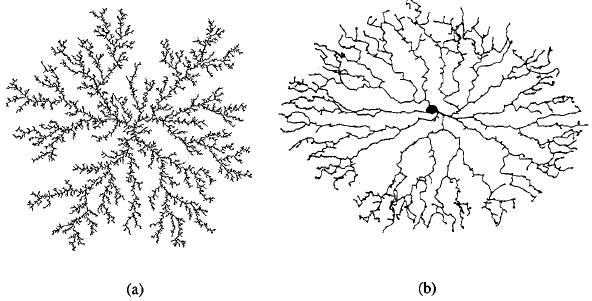
14.4 Fractals or Space-Filling? 499
Figure 14.11. (a) Typical pattern generated by diffusion limited aggregation. (From Bassingthwaighte et
al. 1994 and reproduced with permission) (b) A typical amacrine cell from the central region of the rabbit
retina: scale bar is 100 µm (from Figure 14.1). (After Tauchi and Masland 1984) It is premature to draw any
conclusions as to the mechanism which forms (b) solely by visual comparison between it and the pattern in
(a).
when a particle comes into contact with another particle it sticks to it and can no longer
move. The process is usually started with a seed of stationary particles onto which re-
leased particles eventually diffuse. In this way a spatial pattern is dynamically formed
which is fractal in character. In this DLA example we can compute the fractal dimen-
sion theoretically; it is 1.7. We can, of course, also use the box dimension method, for
example, to compute it from the figure. Now compare the pattern in Figure 14.11 and
the cell patterns in Figure 14.1. It has often been suggested, for example, by Caserta et
al. (1990) and Schierwagen (1990), that the shape of neuronal cells may be determined
by a diffusion limited aggregative process. This is an unjustified conclusion to draw
from mere visual similarity.
Any model mechanism, such as diffusion limited aggregation, must be judged
against other biological spatial patterning generators by the experiments each of them
suggests. It is only by these that they can be differentiated. In the light of the easy
generation of hypothetical ferns, cauliflowers, trees and so on, it is easy to forget the
main purpose of studying pattern formation in biology, namely, to try and discover the
underlying biological processes which produce the spatial patterns.
This page intentionally left blank

Appendix A. Phase Plane Analysis
We discuss here, only very briefly, general autonomous second-order ordinary differen-
tial equations of the form
dx
dt
= f (x, y),
dy
dt
= g(x, y). (A.1)
We present the basic results which are required in the main text. There are many books
which discuss phase plane analysis in varying depth, such as Jordan and Smith (1999)
and Guckenheimer and Holmes (1983). A good, short and practical exposition of the
qualitative theory of ordinary differential equation systems, including phase plane tech-
niques, is given by Odell (1980). Phase curves or phase trajectories of (A.1) are solu-
tions of
dx
dy
=
f (x, y)
g(x, y)
. (A.2)
Through any point (x
0
, y
0
) there is a unique curve except at singular points (x
s
, y
s
)
where
f (x
s
, y
s
) = g(x
s
, y
s
) = 0.
Let x → x −x
s
, y → y −y
s
; then, (0, 0) is a singular point of the transformed equation.
Thus, without loss of generality we now consider (A.2) to have a singular point at the
origin; that is,
f (x, y) = g(x, y) = 0 ⇒ x = 0, y = 0. (A.3)
If f and g are analytic near (0, 0) we can expand f and g in a Taylor series and,
retaining only the linear terms, we get
dx
dy
=
ax + by
cx +dy
, A =
ab
cd
=
f
x
f
y
g
x
g
y
(0,0)
(A.4)
which defines the matrix A and the constants a, b, c and d. The linear form is equivalent
to the system

502 Appendix A. Phase Plane Analysis
dx
dt
= ax +by,
dy
dt
= cx +dy. (A.5)
Solutions of (A.5) give the parametric forms of the phase curves; t is the parametric
parameter.
Let λ
1
and λ
2
be the eigenvalues of A defined in (A.4); that is,
a − λ b
cd−λ
= 0 ⇒ λ
1
,λ
2
=
1
2
(a + d ±[(a +d)
2
−4detA]
1/2
). (A.6)
Solutions of (A.5) are then
x
y
= c
1
v
1
exp[λ
1
t]+c
2
v
2
exp[λ
2
t], (A.7)
where c
1
and c
2
are arbitrary constants and v
1
, v
2
are the eigenvectors of A correspond-
ing to λ
1
and λ
2
respectively; they are given by
v
i
= (1 + p
2
i
)
−1/2
1
p
i
, p
i
=
λ
i
−a
b
, b = 0, i = 1, 2. (A.8)
Elimination of t in (A.7) gives the phase curves in the (x, y) plane.
The form (A.7) is for distinct eigenvalues. If the eigenvalues are equal the solutions
are proportional to (c
1
+c
2
t) exp[λt].
Catalogue of (Linear) Singularities in the Phase Plane
(i) λ
1
, λ
2
real and distinct:
(a) λ
1
and λ
2
have the same sign. Typical eigenvectors v
1
and v
2
are illustrated
in Figure A.1(a). Suppose λ
2
<λ
1
< 0. Then, from (A.7), for example, for
c
2
= 0, c
1
= 0,
x
y
= c
1
v
1
exp[λ
1
t],
so the solution in the phase plane simply moves along v
1
towards the origin
as t →∞in the direction shown in Figure A.1(a) — along PO if c
1
> 0
and along QO if c
1
< 0.
From (A.7) every solution tends to (0, 0) as t →∞since, with λ
2
<
λ
1
< 0, exp[λ
2
t]=o(exp[λ
1
t]) as t →∞and so
x
y
∼ c
1
v
1
exp[λ
1
t] as t →∞.
Thus, close enough to the origin all solutions tend to zero along v
1
as shown
in Figure A.1(a). This is called a node (Type I) singularity. With λ
1
≤ λ
2
<
0 it is a stable node since all trajectories tend to (0, 0) as t →∞.Ifλ
1
>
λ
2
> 0 it is an unstable node; here (x, y) → (0, 0) as t →−∞.
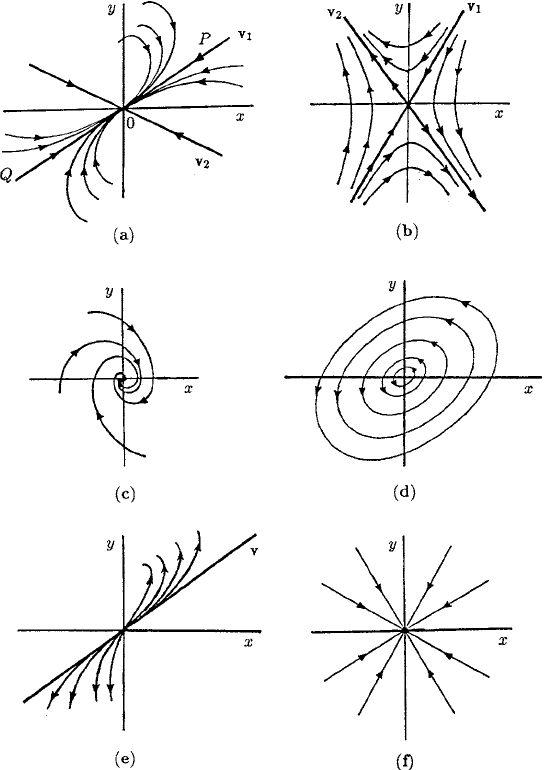
Appendix A. Phase Plane Analysis 503
Figure A.1. Typical examples of the basic linear singularities of the phase plane solutions of (A.4). (a) Node
(Type I): these can be stable (as shown) or unstable. (b) Saddle point: these are always unstable. (c)Spiral:
these can be stable or unstable. (d) Centre: this is neutrally stable. (e) Node (Type II): these can be stable or
unstable. (f) Star: these can be stable or unstable.
(b) λ
1
and λ
2
have different signs. Suppose, for example, λ
1
< 0 <λ
2
then
v
1
exp[λ
1
t]v
1
→ 0 along v
1
as t →∞while v
2
exp[λ
2
t]→0 along v
2
as
t →−∞.
There are thus different directions on v
1
and v
2
: the solutions near (0, 0)
are as shown in Figure A.1(b). This is a saddle point singularity. It is always
unstable: except strictly along v
1
any small perturbation from (0, 0) grows
exponentially.
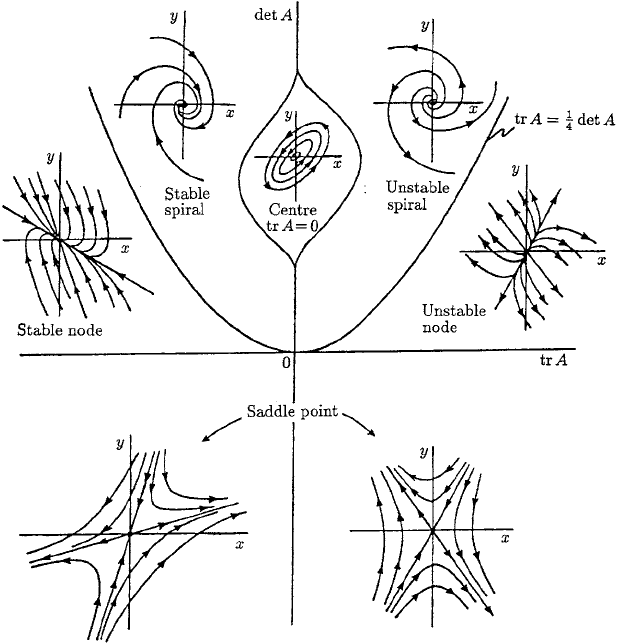
504 Appendix A. Phase Plane Analysis
(ii) λ
1
,λ
2
complex: λ
1
,λ
2
= α ± iβ, β = 0. Solutions (A.7) here involve exp[αt]
exp[±iβt] which implies an oscillatory approach to (0, 0).
(a) α = 0. Here we have a spiral, which is stable if α<0 and unstable if
α>0; Figure A.1(c) illustrates a spiral singularity.
(b) α = 0. In this case the phase curves are ellipses. This singularity is called
a centre and is illustrated in Figure A.1(d). Centres are not stable in the
usual sense; a small perturbation from one phase curve does not die out
in the sense of returning to the original unperturbed curve. The perturbation
simply gives another solution. In the case of centre singularities, determined
by the linear approximation to f (x, y) and g(x, y), we must look at the
higher-order (than linear) terms to determine whether or not it is really a
spiral and hence whether it is stable or unstable.
Figure A.2. Summary diagram showing how tr A and det A,whereA is the linearisation matrix given by
(A.4), determine the type of phase plane singularity for (A.1). Here det A = f
x
g
y
− f
y
g
x
,trA = f
x
+ g
y
,
where the partial derivatives are evaluated at the singularities, the solutions of f (x, y) = g(x, y) = 0.
Appendix A. Phase Plane Analysis 505
(iii) λ
1
= λ
2
= λ. Here the eigenvalues are not distinct.
(a) In general, solutions now involve terms like t exp[λt] and there is only one
eigenvector v along which the solutions tend to (0, 0).Thet in t exp[λt]
modifies the solution away from (0, 0). It is called a node (Type II) singu-
larity, an illustration of which is given in Figure A.1(e).
(b) If the solutions do not contain the t exp[λt] term we have a star singularity,
which may be stable or unstable, depending on the sign of λ. Trajectories in
the vicinity of a star singularity are shown in Figure A.1(f).
The singularity depends on a, b, c and d in the matrix A in (A.4). Figure A.2
summarises the results in terms of the trace and determinant of A.
If the system (A.1) possesses a confined set (that is, a domain on the boundary ∂ B
of which the vector (dx/dt, dy/dt) points into the domain) enclosing a single singular
point which is an unstable spiral or node then any phase trajectory cannot tend to the
singularity with time, nor can it leave the confined set. The Poincar
´
e–Bendixson theorem
says that as t →∞the trajectory will tend to a limit cycle solution. This is the simplest
application of the theorem. If the sole singularity is a saddle point a limit cycle cannot
exist; see, for example, Jordan and Smith (1999) for a proof of the theorem, its general
application and some practical illustrations.
